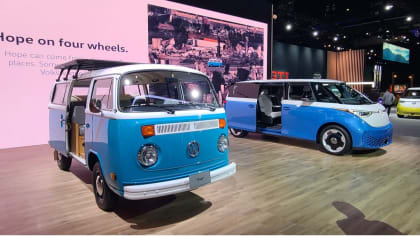PLUG AND PLAY
2012 Toyota Prius Plug-in Hybrid
This article is from our archives and has not been updated and integrated with our "new" site yet... Even so, it's still awesome - so keep reading!
Published on Thu, Aug 16, 2012
By: The LACar Editorial Staff

By Roy Nakano
When Pete Nortman of EnergyCS (see LA Car's Positive Energy) designed the first commercially available aftermarket Prius plug-in hybrid electric-gas car, the folks at Toyota were interested. According to Nortman, the Toyota engineers spent some quality time reviewing the product. While they were impressed with the work, but it was not a direction that Toyota wanted to take. Or so they said. Eight years later, Toyota has introduced its version of the Prius plug-in hybrid.
Why a Plug-in?
In case you’re wondering why anyone would want to put a plug on a hybrid vehicle, it all comes down to fuel economy. While a regular hybrid gets great gas mileage, a plug-in hybrid has extra batteries to allow it to operate more in pure electric mode. The end result is a car that needs to operate the gas engine less, which translates to greater overall fuel economy.
When LA Car obtained Toyota’s first foray into plug-in technology, it decided to give Pete Nortman the same opportunity he gave to Toyota—i.e., allow him to spend some quality time to examine Toyota’s final product.

Origins
Flashback to 1997: Three years before its introduction into the United States, Pete Nortman drove his first Prius. The experience left an indelible impression on him. It was at that point Nortman decided he wanted to build a plug-in version of the car. Eight years later, his company, Energy Control Systems Engineering, otherwise known as EnergyCS, came out with a plug-in version of the Prius.
Since then, Nortman has become intimately familiar with the Prius. “The more we pick apart the Prius, the more we’re amazed how good a car this is,” Nortman said. “One can see where Toyota has gone the extra mile to over-engineer some of the components.”

Toyota’s PIP
So what about Toyota’s Plug-in Prius (affectionately known as the PIP)? Nortman, for one, is mightily impressed. “I want to buy this car,” says Nortman. He says he’s flattered Toyota reached some of the same design and execution conclusions that he did when setting out to build a plug-in Prius. It’s the final product that matters, and Toyota delayed the estimated time of arrival for the Prius Plug-in to make sure it got it right. Even the prototypes of the PIP that Toyota allowed journalists to drive differs from the final product—and indication that they left no stone unturned to further perfecting the PIP.
The driving impressions of the regular Prius are well documented (see LA Car’s http://www.lacar.com/?p=13589 Smug Alert Still). So we’ll just cut to the chase: What does the PIP add to the regular Prius? It all depends on how long your commute is and/or whether your office has an available electric outlet. The PIP can run in pure electric mode for around 13 miles. If your commute is within that distance, you can virtually operate the car without visiting a gas station. In addition, the car is super quiet in pure electric mode. It shares this magical sensation with all-electric vehicles. However, if you go over that range, the car operates as a hybrid, which means you’ll still be getting great gas mileage and won’t have to worry about the car dying after you run out of electric storage. As a result, the PIP is one of the very few electric cars without the dreaded range anxiety associated with pure electric vehicles. The EPA rates the fuel economy at 95 MPGe (electric + gas).
Aside from the obvious fuel economy and noise level attributes, the Prius Plug-in Hybrid sports a slightly higher level of cosmetic trim than the regular Prius. We also found the PIP to have a better ride than the regular Prius. The PIP is heavier than the regular Prius, due to its extra battery load, and it rides like a heavier, bigger car.

Regular Prius vs. Plug-in Prius
The Plug-in model is offered in two trim levels: Standard and Advanced. The standard trim provides the features of the Prius Two Liftback, plus some features from the upscale Prius Three and Prius Four grades. All Prius Plug-in Hybrids have a new touch-screen Display Audio and navigation system with rear backup camera and Toyota’s new Entune™ multimedia services.
The Prius Plug-in also comes with wheels that differentiate it from the regular model, LED Daytime Running Lights, new driver-feedback screens, heated front seats, Smart Key System on three doors with push-button start and remote illuminated entry, and the Touch Tracer Display. The latter features touch sensors on the steering wheel switches that are designed to reduce driver eye movement for better concentration on the road. When the driver touches the audio or info switch located on the steering wheel, a duplicate image is displayed on the instrument panel, directly in front of the driver.
The Advanced trim level adds Head-Up Display, LED headlamps, SofTex interior seat trim, eight-way adjustable power driver seat, a JBL® premium audio and HDD navigation system and exclusive Entune Plug-in Hybrid Applications for smartphones. Additional safety features in the Advanced level include the Pre-Collision System with Dynamic Radar Cruise Control and Safety Connect system. The latter can access a call center with a live operator who can dispatch police and emergency vehicles. The system combines automatic collision notification and a stolen vehicle locator feature, which can track the location of the stolen vehicle via GPS and help guide police to recover it.

The most lavish Prius ever
Our test model came equipped with the Advanced trim level, and we must say it is the most lavish, most luxurious Prius we have ever driven. If that is what you want, this is the car for you. If you are drawn in by the ultra-tech pure electric operation and your commute is short enough to take full advantage of the electric motor’s short range, this is the car for you. On the other hand, if you just want the best hybrid bang for the dollar, it’s hard to beat the regular, tried-and-true Prius.
Perhaps the most flattering testament in favor of Toyota’s Plug-in Prius comes from the man that marketed the first one as an aftermarket conversion. Pete Nortman has now moved onto other products, but having given the PIP a careful examination, he wants one—real bad. If imitation is the sincerest form of flattery, what does it say if the originator of the PIP has seen Toyota’s version and gives it a heap of praise?
SUMMARY JUDGMENT:
For techies and short-range commuters, the Plug-in Prius is worth the wait. For those seeking the best hybrid bang for the dollar, the regular Prius is still hard to beat.
For more information about Toyota products, go to www.toyota.com

SPECIFICATIONS Name of vehicle: 2012 Toyota Prius Plug-in Hybrid Price: $32,000, base price $39,525, as tested, includes the Premium HDD Navigation System, plus the Head-up Display, Dynamic Radar Cruise Control, Pre-Collision System and Lane Keep Assist. The Pre-Collision System retracts the front seatbelts and applies the brakes in certain conditions when it determines that a crash is unavoidable. Lane Keep Assist can help the driver stay within the lane. EPA fuel economy rating (miles per gallon equivalent): 95 MPGe (electricity + gas)/50 mpg (gasoline only) Engine: 1.8-liter four-cylinder engine with VVT-i Electric motor: Permanent magnet synchronous motor Horsepower: Engine horsepower: 134 hp @ 5200 rpm (hybrid) Electric motor power output: 80 hp Engine torque: 105 pound-feet @ 4000 rpm (gas) 153 pound-feet @ 0 rpm (electric) Transmission: Electronically controlled continuously variable transmission Drive System: Front-wheel-drive Hybrid battery pack: litium ion Wheels and tires: 15-inch alloy wheels and P195/65R15 all-season tires Dimensions (inches) Overall Length: 175.6 Overall Width: 68.7 Overall Height: 58.7 Curb weight: 3165 pounds Coefficient of Drag: 0.25



